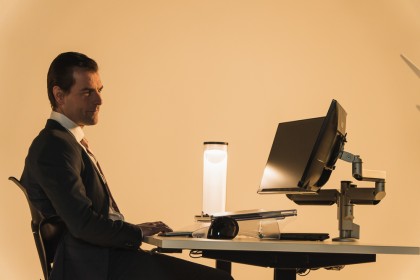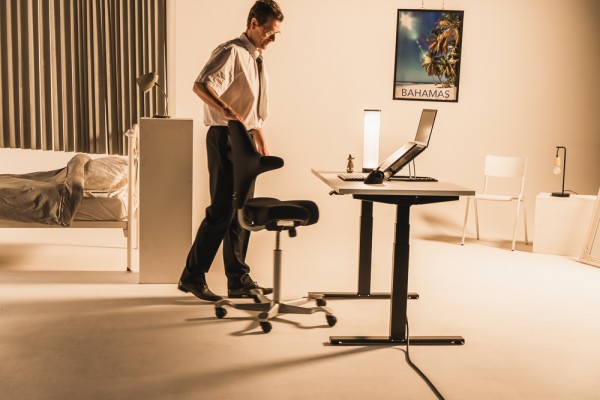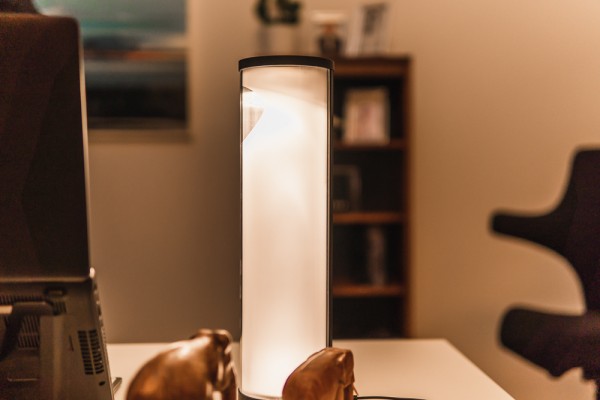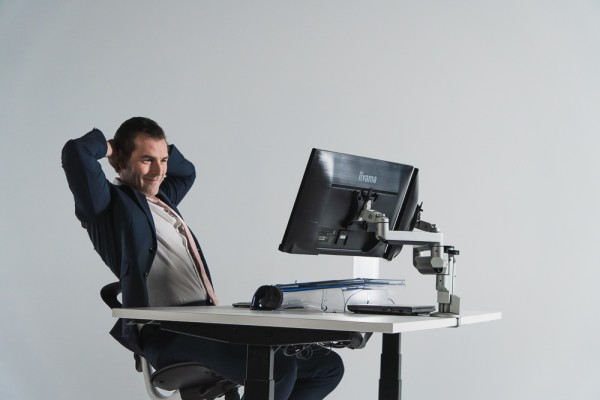Our solutions
Back
Tips for an energetic working day
You have a busy job, a full agenda and a list of all kinds of tasks and things that definitely need to be done. How do you ensure that you start your day as energetic as possible, that you remain energetic and that you still feel like doing something after work? We have listed some useful tips for you, both for employees and employers. If you follow these tips, we guarantee that from now on every day will be a productive day!
Tips for employees
The following eight tips are for employees.
1. Take regular pit stops
Take a 30 second pit stop every 30 minutes. For example, look away from your PC or laptop and take a few deep breaths, or loosen your shoulders, or stand up if you are sitting.
Take a real break for 10 minutes after every hour to an hour and a half of effort: that is, completely disconnect your thoughts from your work task. Preferably without the stimulation of screens and telephones. This is how you ensure mental recovery.
A good break is the mirror image of your work, so the reverse of what you do when you work. If you have a lot of screen work, then no screens during your break. When you talk a lot with people at work, then no/little conversations during your break. When a lot of physical exertion is required during work, make sure to have little physical exertion in your breaks (Fritz et al., 2013). For example, go for a walk outside, have a drink, exercise, do a relaxation or breathing exercise.
Take a real break for 10 minutes after every hour to an hour and a half of effort: that is, completely disconnect your thoughts from your work task. Preferably without the stimulation of screens and telephones. This is how you ensure mental recovery.
A good break is the mirror image of your work, so the reverse of what you do when you work. If you have a lot of screen work, then no screens during your break. When you talk a lot with people at work, then no/little conversations during your break. When a lot of physical exertion is required during work, make sure to have little physical exertion in your breaks (Fritz et al., 2013). For example, go for a walk outside, have a drink, exercise, do a relaxation or breathing exercise.

2. Take a lunch break
In any case, take a lunch break of at least 30 minutes. Get away from your workplace, preferably outside and have your lunch during or with a walk. A staff canteen can be busy and provide a lot of incentives. Make sure you have a moment to be alone when you feel the need to, especially if you are already in a busy environment during work (Fritz et al., 2013).
3. Distance yourself from work
By not thinking about your work, or being busy with it, you protect private time and that ensures better quality recovery and better sleep quality. A ritual of switching off can help with this. End your working day consciously. Turn off your phone, work email, and laptop. Tidy up your desk. Consciously say goodbye to your work: tomorrow is another day.
4. Working from home
The suggestions in this chapter also apply to working at home. However, it can be extra difficult to have sufficient recovery time when working from home. You then have to take care of this entirely on your own, you are not taken along by colleagues in a rhythm or structure of the workplace. Many see the advantages of working from home: less travel time, more opportunities to alternate private activities with work. However, working from home makes it more difficult to distance yourself from work. The roles private and work are intertwined, as it were, and that costs extra energy. When the line between work and private life becomes too blurred, your need for and length of recovery time can increase.
Plan the times of the different roles in your agenda. Try to leave your private situation behind during work, and leave work behind when you are at home. Otherwise you are mentally doing 'double shifts'.
5. Listen for "stress signals"
Listen to stress signals during work and give yourself a break or lower the bar. Examples of stress signals are: concentration problems, irritations, pain, shortness of breath, worrying. A pitfall is to postpone listening to stress signals to private time, such as after a working day or on weekends and holidays. With increasing fatigue, you often fall back on autopilot. You become more passive, react less accurately and slower. For example, you are more likely to wait for someone to call you than to call this person yourself – that takes less energy. The trick is to schedule recovery time on the job to avoid sacrificing private time for recovery.
In any case, take a lunch break of at least 30 minutes. Get away from your workplace, preferably outside and have your lunch during or with a walk. A staff canteen can be busy and provide a lot of incentives. Make sure you have a moment to be alone when you feel the need to, especially if you are already in a busy environment during work (Fritz et al., 2013).
3. Distance yourself from work
By not thinking about your work, or being busy with it, you protect private time and that ensures better quality recovery and better sleep quality. A ritual of switching off can help with this. End your working day consciously. Turn off your phone, work email, and laptop. Tidy up your desk. Consciously say goodbye to your work: tomorrow is another day.
4. Working from home
The suggestions in this chapter also apply to working at home. However, it can be extra difficult to have sufficient recovery time when working from home. You then have to take care of this entirely on your own, you are not taken along by colleagues in a rhythm or structure of the workplace. Many see the advantages of working from home: less travel time, more opportunities to alternate private activities with work. However, working from home makes it more difficult to distance yourself from work. The roles private and work are intertwined, as it were, and that costs extra energy. When the line between work and private life becomes too blurred, your need for and length of recovery time can increase.
Plan the times of the different roles in your agenda. Try to leave your private situation behind during work, and leave work behind when you are at home. Otherwise you are mentally doing 'double shifts'.
5. Listen for "stress signals"
Listen to stress signals during work and give yourself a break or lower the bar. Examples of stress signals are: concentration problems, irritations, pain, shortness of breath, worrying. A pitfall is to postpone listening to stress signals to private time, such as after a working day or on weekends and holidays. With increasing fatigue, you often fall back on autopilot. You become more passive, react less accurately and slower. For example, you are more likely to wait for someone to call you than to call this person yourself – that takes less energy. The trick is to schedule recovery time on the job to avoid sacrificing private time for recovery.
There are many professions where the work is mainly done while sitting. This is less suitable for the mental and physical condition. Sitting for long periods of time is especially harmful. So try to interrupt sitting as much as possible or, for example, work partly standing. It is also recommended to exercise at least 30 minutes a day in a row.
In addition, it is known that rhythmic movement, for example walking, cycling or swimming, clears the mentally taxing impressions of the day and contributes to positive feelings.
For further health benefits and prevention of disease, it is recommended to exercise more intensively two to three times a week, during which you really get out of breath. Ten minutes at a time is already effective. A nice example is the Snaxercise, made popular by cardiologist Tamara Aipassa. Therefore make sure to exercise during and after work.
In addition, it is known that rhythmic movement, for example walking, cycling or swimming, clears the mentally taxing impressions of the day and contributes to positive feelings.
For further health benefits and prevention of disease, it is recommended to exercise more intensively two to three times a week, during which you really get out of breath. Ten minutes at a time is already effective. A nice example is the Snaxercise, made popular by cardiologist Tamara Aipassa. Therefore make sure to exercise during and after work.
7. Provide the correct lighting for your workplace
Poor lighting can have the most adverse impact on the quality of your working day and your well-being in general. The release of the hormones cortisol and melatonin are controlled by your circadian daylight rhythm. Cortisol secretion is highest in the morning making you more productive. While the hormone melatonin steadily decreases with increasing daylight brightness, so you feel fit and well rested during the day. As the daylight decreases and the melatonin increases, you become more tired, which helps you sleep better at night.
So if you work continuously in a light that is comparable to the brighter and colder afternoon light, your body is constantly getting the signal to release cortisol. Your natural daylight rhythm is disrupted and you are less able to rest and sleep less well. So always ensure sufficient daylight by going outside and use biodynamic lighting to get through the day with more energy and to regenerate better before work.
8. Discuss your recovery needs with your manager
Discuss your recovery needs with your manager and indicate how they can support you. By recovery need we mean: your daily need for rest and recovery. The recovery need varies and differs between people. It partly depends on someone's predisposition, the circumstances, the type of work and the stage of life you are in.
So if you work continuously in a light that is comparable to the brighter and colder afternoon light, your body is constantly getting the signal to release cortisol. Your natural daylight rhythm is disrupted and you are less able to rest and sleep less well. So always ensure sufficient daylight by going outside and use biodynamic lighting to get through the day with more energy and to regenerate better before work.
8. Discuss your recovery needs with your manager
Discuss your recovery needs with your manager and indicate how they can support you. By recovery need we mean: your daily need for rest and recovery. The recovery need varies and differs between people. It partly depends on someone's predisposition, the circumstances, the type of work and the stage of life you are in.

Tips for employers
1. Make an inventory of the recovery needs of the employees
Make the recovery needs and recovery options during work negotiable in the organization (including breaks, variation in work, working hours) and relate these to the recovery options after work (such as free time, vacation, other obligations). - Put the subject on the organizational agenda (discuss it in departments, in teams); - Map the individual effort-recovery balance of the employees (interview, questionnaire, risk inventories, physiological measurement). This balance changes over time; - Think along with the employee if he builds up a recovery deficit: propose solutions; - In counseling conversations, ask about recovery needs and give this concrete form; - Let the subject of need for recovery come up in counseling conversations.
2. Support recovery options
The work environment can support the recovery of employees by giving them the opportunity to take care of their own (psychophysiological) recovery at set times. Think of coaching software with regard to pit stops for employees who temporarily or long-term have an extra recovery need.
3. Provide information and lead by example
Provide information about the importance of a good recovery, so that everyone in the organization becomes aware of the importance of building sufficient rest into the agenda, as a counterbalance to effort and stress. Information can be the start of a culture change in the organization. In addition, also set a good example and, as management, also build in recovery time during work and be open about it. Talk about your own recovery needs during (and after) work.
3. Provide information and lead by example
Provide information about the importance of a good recovery, so that everyone in the organization becomes aware of the importance of building sufficient rest into the agenda, as a counterbalance to effort and stress. Information can be the start of a culture change in the organization. In addition, also set a good example and, as management, also build in recovery time during work and be open about it. Talk about your own recovery needs during (and after) work.

4. Manage expectations
It often happens that the mutual expectations of employees and employers are not sufficiently clear. Expectations that are too high or unrealistic can hinder employee recovery. That is why it helps as an employer and employee to make clear agreements about mutual expectations. It concerns questions such as:
5. Maintain and promote autonomy
Research has shown that people need influence and control over their work to stay healthy (Choi, et al., 2011). It is then about the way the work is done, whether breaks can be taken and whether a chat with colleagues can be made.
A production worker must do the work within a certain time and cannot delegate. Employees who experience a high workload, but who can (co-) decide for themselves about the execution, the order and the pace in which they have to do their task, report fatigue complaints less often. In addition, being able to participate in decisions about leave and working hours also promotes a decrease in the number of fatigue complaints. This is because employees can then distribute their workload better (CBS, 2020).
Time writing seems efficient, but it decreases people's recovery time and creativity. The space for relaxation is, as it were, taken off the agenda. People start to feel like work robots and start to behave as such (Marqueze et al., 2016).
6. Plan 'air holes', also during online consultations
A workday is effective if there are 6-7 hours of productive time (Loannides & Mavroudeas, 2020). People spend the other 1 to 2 hours on work organization and self-care; think of (mini) breaks, going to the toilet, switching from one activity to another. Also take these kinds of 'air holes' into account in the planning. In addition, planning that takes unexpected events into account can reduce work stress.
Due to the corona crisis, we see employees who have fully planned their days with online meetings. [SR1] Conversations that used to take place at the workplace or in between in the corridors and at the coffee machine are now conducted via the computer. As a result, people sit behind their screens from early in the morning until late in the afternoon. People who recognize this are advised to consciously plan 'meeting-free' time; for example, no online meetings before 09:00, between 12:00 and 13:00 and after 16:30.
When it comes to one-on-one conversations, you can also occasionally "walking bells" (with the phone and earplugs in and walking outside and have the conversation).
7. Give people enough good light
Good lighting is important for the computer workplace in several ways. Lighting conditions not only affect our physical comfort when working on screens, but also have a major impact on our well-being and performance. Good lighting conditions exist when there are no disturbing reflections and glare, when there is no false contrast and when the brightness is good. It is also important that both horizontal and vertical lighting of the entire work area is present. Adapting to poor lighting conditions often leads to eyestrain, headaches and fatigue. In addition, everyone follows the circadian rhythm, also known as the sleep-wake cycle. This is largely determined by natural daylight. With conventional, artificial lighting, this regular light stimulus is missing and the hormone secretion in our body can get confused. In addition to loss of concentration, stress and problems with falling asleep, this can contribute to long-term psychological disorders.
Biodynamic light should be used more to avoid psychological hazards.
This is light that follows the daylight cycle and adjusts the color temperature and brightness of natural daylight during the day, thus regulating the so-called circadian rhythm. This ensures a balanced day-night rhythm for people. Even seasonal depression (SAD) is counteracted with biodynamic light because it provides the light people lack during the dark winter months. Office workers can generally be helped much better with individual "energy management" and "regeneration".
It often happens that the mutual expectations of employees and employers are not sufficiently clear. Expectations that are too high or unrealistic can hinder employee recovery. That is why it helps as an employer and employee to make clear agreements about mutual expectations. It concerns questions such as:
- How are working hours and breaks arranged?
- What does the availability look like?
- Is the employee expected to work (a lot of) overtime?
- Is there a possibility for extra recovery time after a busy, stressful period?
- Is the employee expected to be available (always) in the evenings, at weekends and during holidays?
- When will people be satisfied with my efforts and results? When am I satisfied?
- What are the expectations and requirements for my professional development?
- Do the expectations match the knowledge, skills and qualities of the employee?
5. Maintain and promote autonomy
Research has shown that people need influence and control over their work to stay healthy (Choi, et al., 2011). It is then about the way the work is done, whether breaks can be taken and whether a chat with colleagues can be made.
A production worker must do the work within a certain time and cannot delegate. Employees who experience a high workload, but who can (co-) decide for themselves about the execution, the order and the pace in which they have to do their task, report fatigue complaints less often. In addition, being able to participate in decisions about leave and working hours also promotes a decrease in the number of fatigue complaints. This is because employees can then distribute their workload better (CBS, 2020).
Time writing seems efficient, but it decreases people's recovery time and creativity. The space for relaxation is, as it were, taken off the agenda. People start to feel like work robots and start to behave as such (Marqueze et al., 2016).
6. Plan 'air holes', also during online consultations
A workday is effective if there are 6-7 hours of productive time (Loannides & Mavroudeas, 2020). People spend the other 1 to 2 hours on work organization and self-care; think of (mini) breaks, going to the toilet, switching from one activity to another. Also take these kinds of 'air holes' into account in the planning. In addition, planning that takes unexpected events into account can reduce work stress.
Due to the corona crisis, we see employees who have fully planned their days with online meetings. [SR1] Conversations that used to take place at the workplace or in between in the corridors and at the coffee machine are now conducted via the computer. As a result, people sit behind their screens from early in the morning until late in the afternoon. People who recognize this are advised to consciously plan 'meeting-free' time; for example, no online meetings before 09:00, between 12:00 and 13:00 and after 16:30.
When it comes to one-on-one conversations, you can also occasionally "walking bells" (with the phone and earplugs in and walking outside and have the conversation).
7. Give people enough good light
Good lighting is important for the computer workplace in several ways. Lighting conditions not only affect our physical comfort when working on screens, but also have a major impact on our well-being and performance. Good lighting conditions exist when there are no disturbing reflections and glare, when there is no false contrast and when the brightness is good. It is also important that both horizontal and vertical lighting of the entire work area is present. Adapting to poor lighting conditions often leads to eyestrain, headaches and fatigue. In addition, everyone follows the circadian rhythm, also known as the sleep-wake cycle. This is largely determined by natural daylight. With conventional, artificial lighting, this regular light stimulus is missing and the hormone secretion in our body can get confused. In addition to loss of concentration, stress and problems with falling asleep, this can contribute to long-term psychological disorders.
Biodynamic light should be used more to avoid psychological hazards.
This is light that follows the daylight cycle and adjusts the color temperature and brightness of natural daylight during the day, thus regulating the so-called circadian rhythm. This ensures a balanced day-night rhythm for people. Even seasonal depression (SAD) is counteracted with biodynamic light because it provides the light people lack during the dark winter months. Office workers can generally be helped much better with individual "energy management" and "regeneration".
Need help? We're here for you
Look at our FAQ or contact us
Many customers preceded you
Read about their experience with BakkerElkhuizen
Select your country and language



